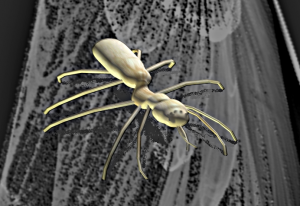BY LETTER
Pspyder
Colony life form native to the planet Trees |
 Image from Steve Bowers |
Physically pspyders consist of two parts: weavers and pspyderweb. Weavers closely resemble terran arachnids, but possess 10 legs and a four segmented body. They are colony creatures, spinning large web structures in the middle and upper branches of the larger tree forms. During the initial exploration of Trees and its lifeforms, it was discovered that the webbing spun by the weavers was not just simple silk, but a complex biological conductor similar to nervous tissue. Signals were found to travel around the web and between the various weavers living on it. At first it was believed that the signals were used by the weavers to communicate with each other in a manner analogous to the chemical and motion cues used by terrestrial hive insects. Further study revealed that this was not the case however. Rather, it is the web which is the actual controlling lifeform.
A weaver colony will instinctively spin a web complex in any suitable location. When the web has reached sufficient complexity it will begin generating neuronal signals which are picked up by sense clusters in the feet and abdomen of the weavers and take control of their nervous systems. Thereafter the web and weaver become a single lifeform: the Pspyder. Possessing an intelligence approximately equal to a terrestrial raccoon the pspyder uses its weavers to both maintain and defend itself and to hunt for food in the form of leaves, fruit and insect equivalents. The weavers gather, hunt, and consume the food and their excrement nourishes the web. This, along with moderate sunlight and rain, is all the pspyder needs to survive.
The exact classification of the creature as a plant, an animal, an insect or something in-between remains a point of debate with amateur biologists to this day. Other members of the same phyle, such as Honeywhips, use the living web tissue in many different ways.
Pspyders in the wild generally live 6-8yrs. However, specimens in captivity have been known to live as long as 12yrs. An adult pspyder is sub-sophont and about as intelligent as a baseline terragen raccoon or beaver. Adult pspyders range in size from about a meter across to 3 meters depending on species. On rare occasions larger specimens have been found but they exhibit no greater intelligence than their more normal sized brethren. There appears to be an upper limit on the level of complexity achievable within a web structure although some biologists believe that barring major climate change or natural disaster, the species may eventually evolve to sentience. A number of provolved intelligent Pspyder clades have been developed artificially, and are becoming increasingly common in the galactic southern region of the Terragens Sphere.
Pspyders have two methods of reproduction: internal and external. Internal reproduction is used to replace weavers as they are killed by predators or lost to aging (a weaver lifespan is about 90 days). During internal reproduction the weavers of a particular pspyder lay eggs at special points within the web structure. Spores released by the web at these points fertilize the eggs which mature and then hatch into new weavers for the use of the web.
Pspyders reproduce externally by releasing spores into the air in the spring. Some of the spores eventually become trapped in the body hair of the weavers of other webs where they are groomed away and consumed. Hormonal signals released by the spores both fertilize the eggs of the weavers and prevent them from being fertilized by the spores of their web. The offspring produced leave the web after hatching and set out to create their own webs in some suitable location.
Pspyders fill an ecological niche similar to that of social insects or small animals on Earth. They prey on smaller creatures and consume plant matter and are in turn consumed themselves. Their neural control signals function purely via touch and are not effected by atmospheric electromagnetic phenomena to any greater or lesser degree than any other animal.
Related Articles
Appears in Topics
Development Notes
Text by Todd Drashner
Initially published on 16 November 2003.
Initially published on 16 November 2003.






